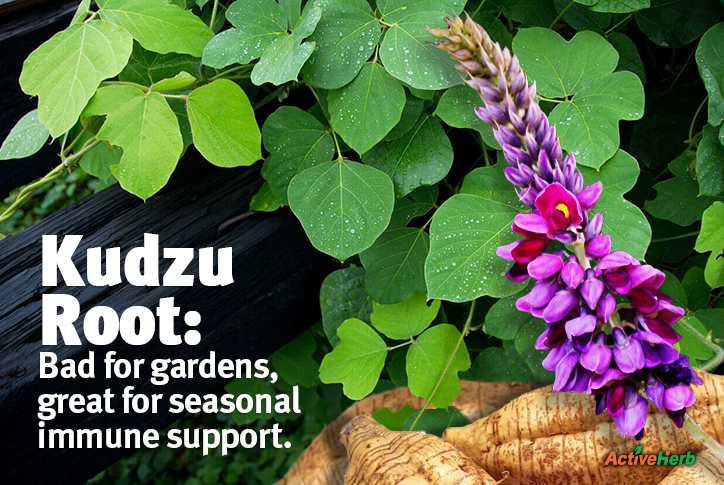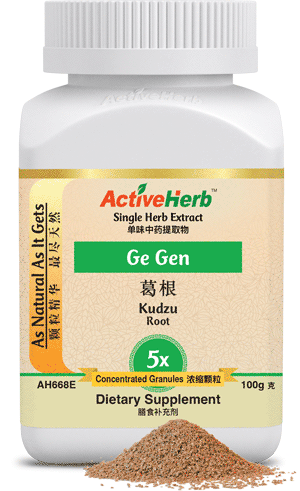Kudzu Root: For Seasonal Immune Support Don’t Weed Out This Invasive Species

What a monstrous reputation! Known as “foot-a-night-vine” and “the vine that ate the South,” kudzu is frequently placed in the top 10 list of invasive species. It’s easy to see why for anybody who has ever driven down a country road in the Deep South of the USA, where the vine is most common. Left untouched, kudzu can swallow abandoned cars and junk yards (which to some people might not be a bad thing.)
First planted in the immediate aftermath of the Great Depression’s Dust Bowl era to combat soil erosion, kudzu was later planted on the sides of highways and railroads to cover up erosion from construction projects. Because kudzu can grow a meter a day, it’s easy to see how quickly it can completely cover utility poles, transforming them into an emerald shaggy beast.
But kudzu doesn’t need to be completely eviscerated from the American landscape. All it needs is a good publicist. One of the rare positive mentions of kudzu is a 2015 Smithsonian article that claims that the vine, which is a member of the bean family, isn’t as pernicious to the environment as most people believe.
The oft-repeated claim that kudzu spreads at the rate of 150,000 acres a year—an area larger than most major American cities—is false, the Smithsonian article claims. Rather, the true rate of growth, according to the Forest Service, is no more than 2,500 acres a year, or 4 square miles. That’s not a very scary figure.
Kudzu Root In TCM: What’s It Used For?
Kudzu root or Ge Gen as it’s known in pinyin Chinese (Mandarin spelled out phonetically in English) is in the class of traditional Chinese medicinal herbs that release the exterior. You can think of the exterior as your superficial layer of skin. This is where your Wei Qi or protective Qi, or what in the west would be called the immune system, resides.
The difference between a mild cough quickly going away or progressively getting worse all depends on the strength of your Wei Qi.
Kudzu root supports Wei Qi and is one of the most legendary herbs for repelling Wind-Cold invasions. How do you know if your body is being invaded by Wind-Cold? Your body will feel cold even if you’re in a room that’s warm. Or you may one minute feel freezing and the next very hot.
When a seasonal Wind-Cold invasion defeats your Wei Qi, tightness in the neck, back or shoulders can manifest. Kudzu root is well-known for resolving Wind-Cold symptoms.
—> Order the Guang Ci Tang formula, Ge Gen Tang Pian, which contains the namesake herb. Known as Kudzu Relaxe, this formula is handy to have in case your body is being challenged by a Wind-Cold invasion.
By releasing heat in the exterior, Kudzu also “vents rashes”. This means that skin blemishes may not develop into full-blown rashes.
From a TCM perspective, Kudzu also generates fluids. This means that if you really need a thirst-quencher, go for some instant kudzu tea.
Speaking of beverages, kudzu use dates back to at least the 7th century for curbing alcohol consumption.
How Does Kudzu Work?
Kudzu root contains three active isoflavones. Isoflavones are substances in legume (bean) plants that mimic the group of three female sex hormones collectively known as estrogen. The three isoflavones have an anti-alcohol effect and may make people feel physically ill if they drink alcohol.
That’s not to say if you have a drinking problem, all you need is supplement with kudzu. If you do have a drinking problem, you should seek professional help.
Other Health Benefits of Kudzu Root
Kudzu also supports circulation, cognitive function, blood sugar management and bone health, in TCM.
And because kudzu’s main active ingredients have estrogen-like properties, it’s a popular herbal remedy to support the transition to menopause. It also supports skin health.
Conclusion
As you can see, kudzu root has many applications in traditional Chinese medicine. In fact, like licorice root, it’s one of the 50 fundamental herbs of traditional Chinese medicine. Kudzu’s reputation as a therapeutic herb certainly shines more brightly than it does in gardening. There’s certainly more to the herb than its damaged reputation as an invasive species.
References:
Puerarin: a review of pharmacological effects
A Single Dose of Kudzu Extract Reduces Alcohol Consumption in a Binge Drinking Paradigm






